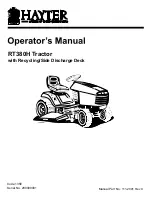
10-15
OPERATION
1.
Operation of the pump
1 - The cylinder block (4) rotates with the shaft (1)
and the piston shoes (6) slide over the flat sur-
face «
A
».
The swash plate (3) moves over the cylindrical
surface «
B
»; the angle «
a
» between the axis of
the shaft (1) and the axis
X
of the swash plate (3)
can be changed to alter the stroke of the pistons.
Angle «
a
» is known as the «swash plate angle».
2 - When axis
X
of the swash plate (3) is at an angle
«
a
» to the shaft (1) and consequently also the
cylinder block (4), the surface «
A
» acts as cam
for the piston shoes (6). As a result, as the shaft
rotates, the pistons (5) stroke inside the cylinder
block (4), thereby creating a difference in the vol-
umes
C
and
D
and thus drawing in and discharg-
ing oil in a quantity equal to this difference in
volume (
D
--
C
=delivery).
In other terms, when the cylinder block (4) ro-
tates, the volume of cylinder
D
is reduced, there-
by forcing out the oil, while the volume of cylinder
C
is increased, thereby drawing oil into the bore.
(Fig. 1 shows the pump condition on completion
of the suction phase in cylinder
D
and the deliv-
ery phase in cylinder
C
).
3 - When the axis
X
of the swash plate (3) is parallel
to the axis of the cylinder block (4) (swash plate
angle «
a
»=0), the difference in volume between
C
and
D
inside the cylinder block (6) is 0 and
therefore no oil is pumped (Fig. 2).
(In reality, the swash plate «
a
» is never exactly
equal to zero 0).
4 - Pump delivery is therefore directly proportional
to the swash plate angle «
a
».
2.
Pump delivery control
·
When the swash plate angle «
a
» is increased,
the difference between volumes
C
and
D
in-
creases and consequently so does the pump
delivery
Q
.
The swash plate angle is changed by the control
piston (8).
·
The control piston (8) moves in accordance with
the pressure signals received from the Load
Sensing valve and the pressure control valve.
The linear movement of the piston is transmitted
to the swash plate (3), which is supported by the
cylindrical surface of the pump housing (2); the
swash plate thus moves through a semicircular
arc (Fig. 3).
D0000530
4
C
6
S
A
3
1
x
␣
B
D
D
4
C
3
x
Fig. 1
Fig. 2
D0003210
C
8
␣
D
3
2
Fig. 3
HYDRAULIC PUMP



































